by Amineddoleh & Associates LLC | Oct 31, 2020 |
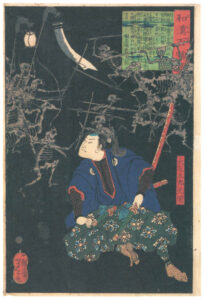 Stories of ghosts, demons, and other horrors are common to all cultures, and most cultures around the world have art portraying the supernatural. Since ancient times, Japan’s religion and culture has been deeply bound with ghosts, called yūrei. Both feared and revered, yūrei are part of the deep magic; a foundational belief that humans have a god inside of them.
Stories of ghosts, demons, and other horrors are common to all cultures, and most cultures around the world have art portraying the supernatural. Since ancient times, Japan’s religion and culture has been deeply bound with ghosts, called yūrei. Both feared and revered, yūrei are part of the deep magic; a foundational belief that humans have a god inside of them.
Tsukioka Yoshitoshi, born in 1839 in Japan, is known as one of the last great masters of the Japanese woodblock print. One of his masterpieces a series of works, 100 Ghost Stories from China and Japan. The series, created in 1865, includes images of skeletons, ghosts, and other supernatural creatures. One well-known print is Japanese samurai warrior, Oya Taro Mitsukuni watching a battle scene between armies of skeletons.
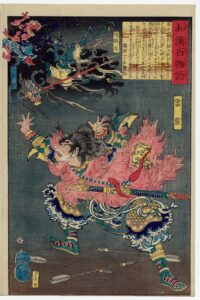
Leizhen (Raishin), MFA Boston
The Museum of Fine Arts in Boston (MFA) owns Leizhen (Raishin), from the series. The work, signed by Ikkaisai Yoshitoshi ga, was purchased by William Sturgis Bigelow in 1911 and then gifted to the MFA. Bigelow was a prominent American collector of Japanese art. He lived in Japan for seven years. The Japanese government authorized him and two other Americans to explore parts of Japan that had been closed to outside viewers for centuries. During his time there, he acquired valuable art, including the mandala from the Hokke-do of Tōdai-ji, one of the oldest Japanese paintings to ever leave Japan. Bigelow donated approximately 75,000 objects of Japanese art to Boston MFA. Due to the huge donation, the still has the largest collection of Japanese art anywhere outside Japan.
Perhaps even more haunting is a series of fourteen works, the Pinturas Negras (Black Paintings), created between 1819 and 1823 by Spanish painter Francisco Goya. The works depict dark themes that reflected Goya’s own fears and his bleak view of humanity, in part due to the fact that the Spanish master was going deaf. At the age of 72, Goya moved into a home outside of Madrid known as La Quinta del Sordo (the Deaf Man’s Villa). The previous owner was deaf, and Goya was nearly deaf by the time he moved into the home. During this despairing time, Goya painted a series of unsettling works, such as murals on the walls of his house. They were eventually transferred to canvas.

Witches’ Sabbath, El Prado
One of the most macabre is the work now known (Goya did not title the murals) as the Witches’ Sabbath (El Aquelarre) or The Great He-Goat (El Gran Cabrón). Like most of the other works in the series, it was painted with dark and earth-toned colors. The painting depicts a witches Sabbath attended by the Devil in the form of a goat. The He-Goat appears as a silhouette painted entirely in black, except for one eye. Facing the demonic creature is a coven of witches and warlocks, portrayed with hideous features. The series of works was acquired by the Baron Emile d’Erlanger when he purchased the “Quinta” in 1873. He had the murals transferred to canvas, but they suffered great damage. The Baron ultimately donated the works to the government of Spain, which in turn moved them to the Prado, a national museum located in Madrid, to be publicly viewed.
The portrayal of devils and demons in works of art dates back millennia. Featured in The Exorcist, Pazuzu is the main antagonist who is exorcized from its victim. But the demon was not just the creation of the author of the The Exorcist, William Peter Blatty. The demon derives from Assyrian and Babylonian mythology, where it was considered the king of the demons of the wind, and the son of the god Hanbi.
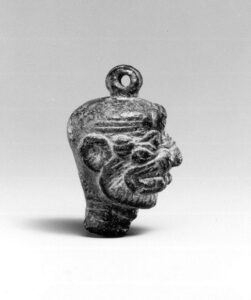
Pendant of Pazuzu, Metropolitan Museum of Art
On display at the Metropolitan Museum of Art (the Met) is a small pendant of the demon, dating from the 8th to 7th century BC. The pendant has bulging eyes, bulbous forehead protrusions, and short beard that rings the snarling open mouth, atop an incongruously thin neck. These are his unmistakable features.
According to the Met, Pazuzu appears on many plaques and amulets, sometimes as a figure with wings and a scorpion tail. The earliest image of Pazuzu dates to the late 8th century B.C., relatively late in the history of demonic imagery in Mesopotamia. The museum states that this was a period when the Assyrian royal administration was intensely focused on collecting magical knowledge and studying the supernatural world, and priests and exorcists were actively engaged in codifying these systems of knowledge. As a result, a rich variety of magical images and texts from Assyria in this period have survived. The pendant was sold at Hôtel Drouot, Paris, on May 19-20, 1987, and eventually it was acquired by the museum in 1993, purchased at Sotheby’s New York, on June 12, 1993.
In addition to the demonic pendant, the Met owns other spooky art, including this photograph of a ghostly apparition.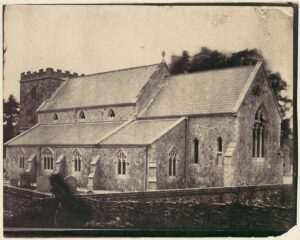
by Amineddoleh & Associates LLC | Sep 6, 2017 |
Amineddoleh & Associates LLC is pleased to celebrate its first anniversary. The litigation and transactional boutique law firm is recognized for its work in the areas of art, cultural heritage, and intellectual property law.
Since our inception, we have been involved in numerous high-profile matters. The law firm’s founder Leila Amineddoleh served as a consultant to the Brooklyn United States Attorney’s Office in the civil case brought against Hobby Lobby (information about the case is available here and here), and likewise serves as a cultural heritage law expert to the New York District Attorney’s Office for antiquities investigations. In that role, she was involved in the repatriation of looted antiquities from Italy and the recent seizure of an ancient Lebanese bull’s head to Lebanon from the Metropolitan Museum of Art. Amineddoleh also worked as a legal expert consultant for foreign governments in Europe and Asia on repatriation issues.
Amineddoleh & Associates serves the needs of private clients in a number of areas as well. The firm’s first year has been very active with a host of high-stakes art and intellectual property matters, including the following:
- Selling art and collectibles (including military items and rare books) around the globe;
- Serving as legal counsel for a leading international artist concerning his installation at the Smithsonian Institution;
- Demanding restitution of a stolen multi-million dollar collectible now housed in a private European collection;
- Protecting the art and IP of well-known artists, such as Samuel Amoia and Lynx Alexander;
- Recovering artwork for an artist after her sculpture was unlawfully withheld by a gallery;
- Assisting international art dealers and collectors sell works within the US;
- Presenting works for sale to artists’ foundation after performing due diligence and authentication;
- Working with artists’ foundations for licensing and intellectual property permissions;
- Advising on fair use issues for visual artists;
- Providing legal counsel to entertainment marketing agencies, such as The Syndicate;
- Drafting agreements in furtherance of the release of films, such as “Thirst Street;”
- Seeking funding for film projects;
- Demanding rescissions from auction houses for the sales of forged works;
- Representing a nationally acclaimed magician to protect his intellectual property;
- Establishing non-profit organizations and corporate entities;
- Prosecuting trademarks, filing cease and desist demands, and developing intellectual portfolios;
- Drafting contracts for authors, artists, and videogame designers;
- Representing collectors before cultural ministries to receive permission for international sales.
Besides work for our valued clients, Amineddoleh & Associates has been actively weighing in on art and heritage issues in national and international dialogues. We’ve discussed art and heritage issues in numerous publications, including Live Science, Time Magazine, NY Times, Bloomberg News, and iNews. Our founder Ms. Amineddoleh appeared on two nationally aired radio shows, Knowledge@Wharton and WNPR, and she spoke at numerous conferences and presented guest lectures across the country.
Ms. Brennan assisted in co-teaching a course on antiquities at Sotheby’s Institute of Art. She is actively researching current international and federal legislation controlling cultural property, as well as conducting legal research into artists’ estates and foundations. We’ve been published extensively in sources such as Artsy and Artnet, and Ms. Brennan served as the research assistant for Maxwell L. Anderson’s book Antiquities: What Everyone Needs to Know.
The attorneys at Amineddoleh & Associates are pleased to work in the arts in other capacities. Ms. Brennan is a graphic designer and illustrator in her spare time. Ms. Amineddoleh performs classical piano music, and she curated an art crime exhibition at New York University. Michael Rose is a talented painter. We are proud to actively support the arts, as members of arts organizations, such as Lincoln Center Young Patrons, Young Patrons’ of the Hispanic Society of America, and Young Friends of the Philadelphia Museum of Art.
We look forward to another exciting year ahead. In November, Ms. Amineddoleh will be organizing and speaking at a program on art collecting and due diligence for Harvard Business School at the Harvard Club in New York City. In February, she will be leading a lecture at the Philadelphia Museum of Art on the history of art collecting. We are proud to contribute to the Antiquities Coalition in a forthcoming policy piece for the group. In the fall, please look for our contribution to a forthcoming book from Bloomsbury Press, Nazi Law: From Nuremberg to Nuremberg.
For more information on the firm’s practice please visit www.artandiplawfirm.com.
by Amineddoleh & Associates LLC | Aug 1, 2017 |
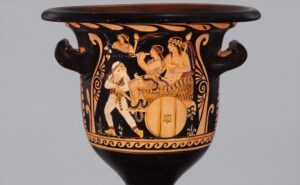 Last night, Tom Mashberg of the NY Times broke the story about an ancient vase that was seized from the Metropolitan Museum of Art (“the Met”). The 2,300-year-old object, the “Python Vessel,” had been displayed at the NY institution since 1989, when it was purchased from Sotheby’s for $90,000. Matthew Bogdanos, a celebrated and Assistant District Attorney in the Manhattan District Attorney’s Office (as well as author and colonel in the United States Marine Corps Reserves), seized the work based on evidence that it was looted from Italy in the 1970s. He was presented with evidence from forensics archaeologist Christos Tsirogiannis that the vase was connected to well-known looter Giacomo Medici. Medici was convicted in a Rome court of conspiring to traffic in ancient treasures, and is perhaps best known for his role in the looting and trafficking of the Euphronios Krater.
Last night, Tom Mashberg of the NY Times broke the story about an ancient vase that was seized from the Metropolitan Museum of Art (“the Met”). The 2,300-year-old object, the “Python Vessel,” had been displayed at the NY institution since 1989, when it was purchased from Sotheby’s for $90,000. Matthew Bogdanos, a celebrated and Assistant District Attorney in the Manhattan District Attorney’s Office (as well as author and colonel in the United States Marine Corps Reserves), seized the work based on evidence that it was looted from Italy in the 1970s. He was presented with evidence from forensics archaeologist Christos Tsirogiannis that the vase was connected to well-known looter Giacomo Medici. Medici was convicted in a Rome court of conspiring to traffic in ancient treasures, and is perhaps best known for his role in the looting and trafficking of the Euphronios Krater.
The Euphronios krater (also known as the Sarpedon Krater) is a red-figure vase attributed to the famous Greek painter Euphronios and the potter Euxitheos, dating from around 515 BCE. The Euphronios Krater is believed to have been illegally excavated sometime in December 1971 near Cerveteri, Italy, from the Greppe di Sant’Angelo region of the town’s ancient Etruscan cemetery, by tombaroli (tomb raiders). The looters sold the vase to Medici who them smuggled it into Switzerland and sold it for $350,000 to an antiquities dealer, Robert Hecht. By this point, the vase, which had been found in a remarkably excellent state, was intentionally damaged and broken into fragments to more easily illegally export it. After restoring the fragmented object, in February 1972, Hecht wrote to Dietrich von Bothmer, the Met’s Curator of Greek and Roman Art, about the krater. In August 1972, the Met bought the vase for $1 million.
Throughout the 1990s, Italian authorities investigated Giacomo Medici, and they eventually found enough evidence to bring legal claims against him. The Italian authorities also demanded the repatriation of the Euphronios Krater from the Met. The case drew international attention and led to the restitution of dozens of Italian artifacts from institutions across the country, including the Met, the MFA in Boston, and the Princeton Art Museum. The return of objects also led to the cultural exchange of artifacts from Italy in the form of long-term loans to the American institutions repatriating looted good. The Euphronios Krater has since returned home and is now on display at the Archaeological Museum of Cerveteri.
In the case of the Python Vessel, Mashberg reports that the Met removed the item from its viewing case and that it is now in the custody of law enforcement agents.
 Stories of ghosts, demons, and other horrors are common to all cultures, and most cultures around the world have art portraying the supernatural. Since ancient times, Japan’s religion and culture has been deeply bound with ghosts, called yūrei. Both feared and revered, yūrei are part of the deep magic; a foundational belief that humans have a god inside of them.
Stories of ghosts, demons, and other horrors are common to all cultures, and most cultures around the world have art portraying the supernatural. Since ancient times, Japan’s religion and culture has been deeply bound with ghosts, called yūrei. Both feared and revered, yūrei are part of the deep magic; a foundational belief that humans have a god inside of them.



